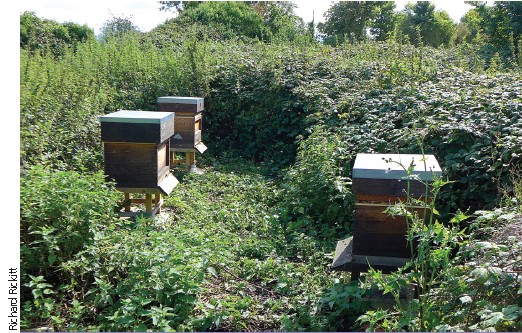The Rise of Bee Rustling - and its Reporting by Stephen Fleming, co-editor
published by BeeCraft in February 2018
At such a difficult time for us all, the theft of hives in Somerset (December 2020) comes as a particularly bitter blow; not only has a beekeeper had his bees and equipment stolen, but the thief is most likely to be another beekeeper. We looked into this crime a couple of years ago and our article offers some useful suggestions.
Newspapers have revelled in news about thefts of bee hives recently, but don’t be too alarmed. It’s more a novelty news item with headlines that can quote thefts of tens of thousands of stolen animals rather than a seriously developing crime trend.
Nonetheless, as any beekeeper who has experienced theft will tell you, it’s a heart- breaking experience and highlights the emotional attachment that beekeepers have to their bees. Fortunately, there are some simple things that you can do to protect your colonies if you think
they are at risk.
Hot Spots
Rural crime in the UK cost £39 million in 2016, according to insurer NFU Mutual. Bee rustling accounted for perhaps at most a very few thousands of pounds and probably never made it into those statistics because few beekeepers insure their colonies against theft. Recent Freedom
of Information requests to UK police forces indicate that there have been 135 reported beerustling
incidents in the past six years, with West Mercia and Lincolnshire being the most affected areas (see panel). BBKA does not keep records ‘because theft is not a phenomenon of beekeeping but of society’.
What seems to have disturbed beekeepers most is that many of the thefts have been sophisticated and could only have been perpetrated by people with a good knowledge of bees – fellow beekeepers, that is.
Recent Rustling
The 2017 season started in April with the theft of six hives and four colonies from second-year beekeeper Amanda Clayton’s out-apiary near Doncaster. A smoker was left at the scene.
In June, Bee Craft reported on a highly sophisticated theft from the Farmers in Kent – hives were
left intact, but frames of brood and bees were stolen! Throughout the summer there was a sporadic drip of bee rustling reports from North Wales to Norfolk. While in the main being sympathetic, police
resources don’t seem to have followed the hives and no one is yet known to have been
apprehended. None of the burgled beekeepers seems to have had any evidence of the identity of the culprits. The phenomenon wasn’t confined to the UK. In New Zealand police seized a truckload of 50 colonies – police said the searching and seizing elements of their operation posed an interesting challenge.In America, of course, the phenomenon took on even bigger proportions with one bee thief being prosecuted for the theft, over several years, of 2500 hives from Californian almond orchards. The value of the stolen goods was estimated at almost $1 million.
In Britain, out-apiaries are obviously at greatest risk from theft, but even then, the risk is small. Vandalism or clumsy or inquisitive animals are more likely to disturb hives. What can beekeepers do to protect from theft?
Protecting Out-apiaries

Do what you can to reduce the visibility of your hives from roads and rights of way. That usually means choosing the site carefully in the first instance, but, for relatively exposed sites, you could encourage scrub growth or request permission for judicious planting. For apiaries close to public thoroughfares, it is a good idea to encourage branches and undergrowth to grow across the entrance to your apiary to disguise it and discourage inquisitive passers-by. And don’t make a dramatic personal appearance if the hive is in a well-frequented area – make your apiary entrances and exits discreetly.
In the apiary, orientate the hives to face the entrance. Vandals and others may be discouraged from wandering through a cloud of bees to do their deed. Encourage the watchful eyes of local farmers and apiary neighbours who will probably be keen to help as they won’t want unwelcome intruders either. Put up a sign within the apiary saying Beware of the Bees. For legal reasons, it may be not be a great idea to advertise how grumpy they might be. Since bees obviously don't read the books,
they are unlikely to notice. Place empty equipment on the side furthest from the entrance –
make sure any intruders have to pass occupied beehives before getting to your easily stolen
equipment. Don’t tell anyone other than BeeBase the specific location of your apiary. You never know who is listening. A fence with a locked gate is a great deterrent but it isn’t always feasible and sensible.
Protecting Hives

A simple and effective way of marking your hives is by branding the hive parts – and even the frames. Of course, branded items need to be found to be traced back to you, but the marks may act
as a deterrent. Bee suppliers offer branding irons with a few letters of your choice from about £25. The branding iron has to be heated by an external source like a blowtorch. There are alternatives, such as an electric iron for pyrography (pictured). This usually needs a corded power source and is a preference for artistic operators. The late Dave Cushman (of the excellent www.dave-cushman.
net website) cobbled together his own device which he would use to create a 1 mm deep burn on boxes and frames. He reckoned that after ten years in all weathers, the scorch marks may have disappeared, but his calling card was unmistakable. Painting or staining offers a way to both camouflage and mark your hives. New York beekeepers became quite adept at this when beekeeping was banned in their city. For anyone using hive staples when transporting hives, it is not a great idea to leave these in place unless it is to keep the hive more stable in high winds.
However, strapping the hive to its stand – especially if the strapping is discreet – can help
protect against high winds, clumsy animals and would-be thieves. There are other cunning methods of protection: the hole in the floor of the hive to allow bees to escape in transit (the hole should of course have some mouseguard protection!). And, of course, we couldn’t possibly endorse the man-trap that sprays creosote – or even honey – when activated!
There are the long-established forms of protection: mitigation. BBKA’s insurance broker offers a
fully comprehensive policy that covers hive thefts.
High-Tech Protection
Microchipping hives (like pets – but not colony individuals!) is often spoken of, but I have never heard of anyone doing this. (Microchipping of a dog usually costs £10–15.) SmartWater might also be an option, but such approaches require the stolen hive to be found and for someone to realise checking for chips or SmartWater is worthwhile. The theft alert system of Arnia, the hive-monitoring system specialist, was called into action in 2015 when the apiary of Jan Doyle, the current chair of
Newbury and District BKA, was targeted (see side panel for her experience). The system worked
technically although the thieves got away, but it is thought to be only the second time that an
Arnia system has had to issue a theft alert (the other involved honey theft in the Czech Republic and the culprits were tracked). The prospect of a standalone tracking device for hives seems some way off. To date, the costs (mainly the power and communications requirements) outweigh the value of the hive and the risk involved, says George Clouston of Arnia, whose company has
investigated possibilities. In the USA, the Bee Corp at Indiana University claims to have developed a QGPS Hive Theft Tracking System. As we go to press, it is about to be demonstrated, although no prices have yet been revealed. Meanwhile, some people are monitoring their apiaries with
internet-enabled video cameras. The costs of cameras are now quite low, but the availability of a good quality internet connection at the apiary is essential if you want to receive an alert on your phone or computer. Infrared night-vision cameras are available for around £100 or less but, of course, location of such cameras is crucial as they provide another theft opportunity. Cameras can usually be set to power-saving mode when no movement is detected, and some can be solar-powered. (Search online for Game Cameras.)
Extract taken from BeeCraft February 2018
Subscribe to BeeCraft Magazine
- £27.00* - Digital Subscription | 12 months
- £45.00* - UK Printed Subscription | 12 months
- £80.00 - UK Printed Subscription | 24 months
* UK residents over the age of 18 can subscribe to BeeCraft via Direct Debit and save up to £7.00 on your subscription. For more information on our Direct Debit scheme, please click here.
- £27.00 - Digital Subscription | 12 months
- £50.00 - Digital Subscription | 24 months
- £67.00 - RoI & European Printed Subscription | 12 months
- £27.00 - Digital Subscription | 12 months
- £50.00 - Digital Subscription | 24 months
- £90.00 - Worldwide Printed Subscription | 12 months



